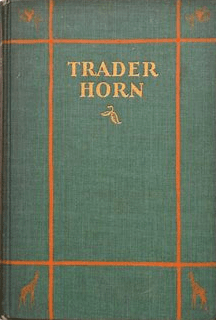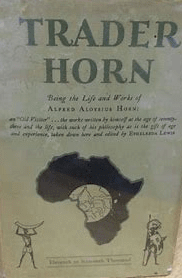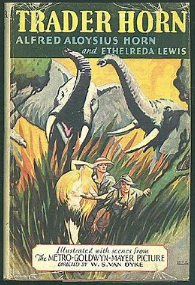Balladeer’s Blog continues its examination of the 1927 book Trader Horn, the quasi-autobiographical account of the British Trader Alfred Aloysius Horn’s adventures in Africa during the late 1800s. The partially factual book spawned multiple movies. For Part One click HERE.
 PART TWO – Aboard the S.S. Angola, the teenaged Alfred Horn approached Africa on his first assignment as a Trade Agent for the firm of Hatson & Cookson, whose business operated from Bonny Brass to Old Calabar and up the Niger River as well as coastal ports along Cameroon.
PART TWO – Aboard the S.S. Angola, the teenaged Alfred Horn approached Africa on his first assignment as a Trade Agent for the firm of Hatson & Cookson, whose business operated from Bonny Brass to Old Calabar and up the Niger River as well as coastal ports along Cameroon.
Their trading territory included the Ogowe River, the shores of which boasted a vast population of gorillas at that time in the early 1870s. Trader Horn features many of Horn’s accounts of the comparative swarms of wildlife throughout Africa in that era before vast depopulation by poachers.
Along the Ogowe River lived the Ashiwa, Fans, and M’pangwes tribes, who hunted the enormous numbers of elephants in Africa at that time. The tribes used the meat and skin of the elephants they killed and traded the priceless ivory tusks with Trader Horn’s firm among others.
That practice was at least more practical than the later tendency of hunters and poachers to kill off elephants by the thousands just to obtain the ivory, leaving the bodies to rot. Those Big Three tribes in terms of Hatson & Cookson’s ivory trade were expert fighters and were among the few tribes who no longer dealt in slaves.
In traveling along the Ogowe River, Alfred Horn and his colleagues were armed to the teeth as they frequently encountered hostile renegades from cannibal tribes along with rampant gorillas, rhinoceroses and other deadly jungle animals. In addition to ivory, the tribes traded ball rubber and more to Horn and others in return for salt, gunpowder and other goods.
 Some aspects of Alfred Horn’s accounts of his travels have been supported by others from the time period, including the rich trade in exotic birds and the way flying fish were so plentiful in the Atlantic Ocean that many would land on the Angola‘s deck before being cooked up for Horn and the others.
Some aspects of Alfred Horn’s accounts of his travels have been supported by others from the time period, including the rich trade in exotic birds and the way flying fish were so plentiful in the Atlantic Ocean that many would land on the Angola‘s deck before being cooked up for Horn and the others.
The Kroo (aka Kru) people were spoken well of by Trader Horn, and teenage Kroo made excellent ship-hands, more than earning their pay. Horn’s firm traded firearms to the Kroo, who were currently at war with the Colony of Liberia.
Ironically, the transplanted African-Americans who ran Liberia treated the native Africans with disdain and bigotry despite resenting that treatment when it was inflicted on them back in the U.S. The warring between Liberia and indigenous tribes in Africa would continue into the 20th Century, as would periodic uprisings by the native Africans living in Liberia.
Along the Bonny River, which was one of the mouths of the Niger River, lay the settlement called Bonny. At the time of Trader Horn’s travels the most influential figure in the area was Chief Oka Jumbo, whose sons were made chiefs of many other local tribes, leaving Oka Jumbo as a virtual emperor of the region.
Oka Jumbo and his people did a brisk trade with Hatson & Cookson, but the area was dangerous because of disease and the chief’s ongoing war with smaller river tribes. Those smaller tribes were preying on and endangering Oka Jumbo’s lucrative palm oil exports, in attempts to erode the influence of the chief and his sons.
 Unfortunately, Oka Jumbo’s people still dealt in slaves to various Muslim and South American countries, since much of the Western World had already banned slavery. The chief himself owned thousands of slaves.
Unfortunately, Oka Jumbo’s people still dealt in slaves to various Muslim and South American countries, since much of the Western World had already banned slavery. The chief himself owned thousands of slaves.
Because of the importance of Oka Jumbo’s goods to Trader Horn’s employers he made a point of ingratiating himself to the chief and over time enjoyed such a good relationship with him that Horn was among the white traders granted membership in the Egbo Society.
I will look at Horn’s experiences with indigenous medicine, an African cryptid and more next time around. For Part Three click HERE.

This could be a hard read through today’s eyes. But, I was struck by his age–teen–entrusted with such a responsible (seemingly) job. I think kids grew up faster back then than now.
Oh, absolutely on both counts!
Interesting story of Trader Horn especially with tribe Oka Jumbo ! Well written
You are very nice for saying so!
🫡🫡🫡
😀 😀 😀